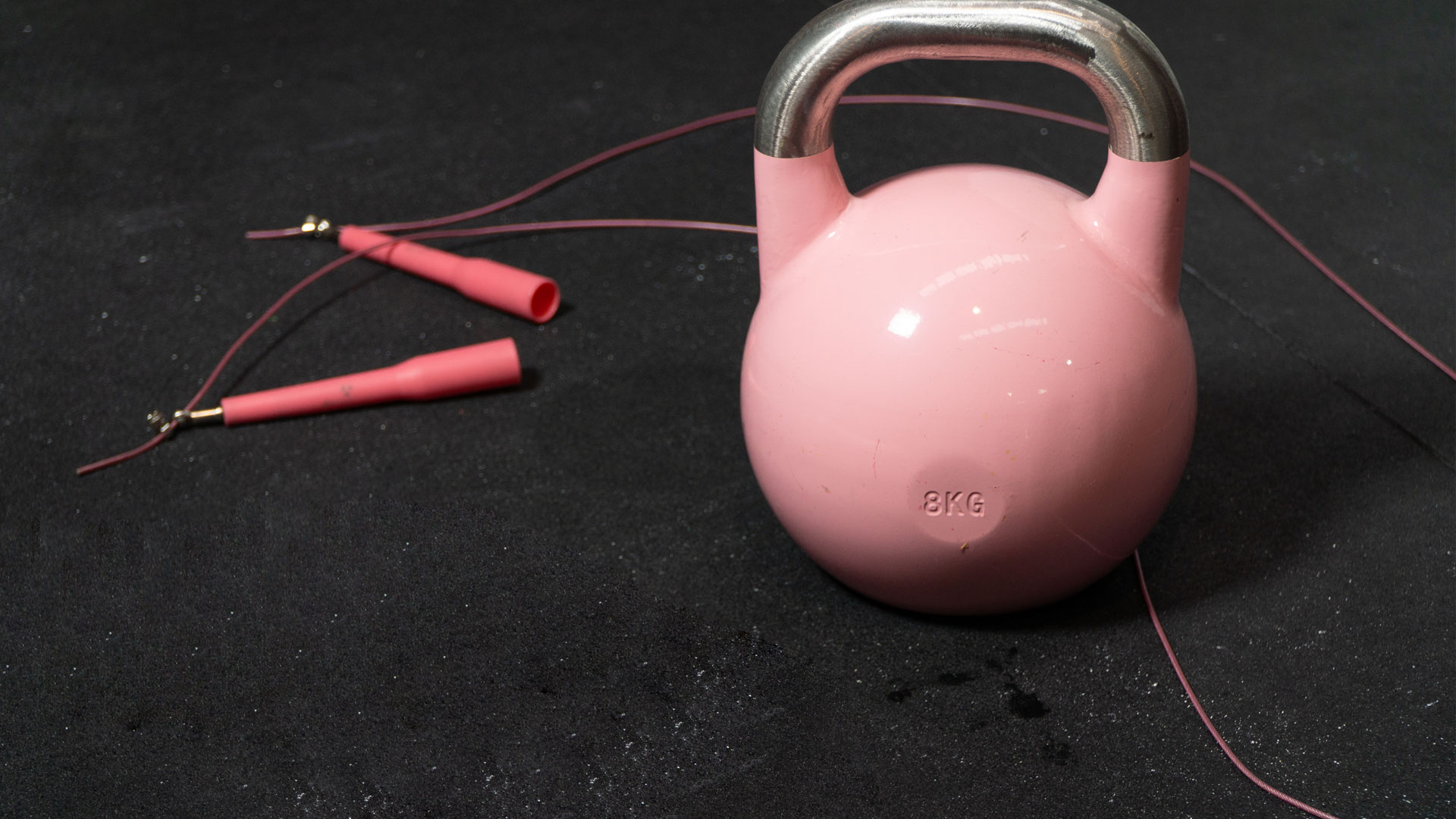Dumbbells vs kettlebells – which are better?
Dumbbells vs kettlebells: which type of resistance training is the most effective workout?


Dumbbells vs kettlebells: which is a better workout and what’s the difference? If you want to build muscle, lose weight, or simply get stronger, adding resistance to your training is a great start.
Both the best adjustable dumbbells and the best kettlebells are ideal for adding resistance and give you the flexibility to work out at home. For those completely new to exercise, dumbbells usually have a short, cylindrical handle and two circular ends while a kettlebell is a weighted ball with a handle attached to the top.
“The key difference between dumbbells and kettlebells is the shape and design,” confirms personal trainer Ross Mitchell. “You'll find the main weight of a kettlebell is outside of the hand instead of either side of it like a dumbbell. This means the loading angles are different which provides potentially more loading,”
The U.S. Department of Health and Human Services recommends that all adults partake in strength training twice a week, working all the major muscle groups. And it makes sense - weight lifting has a ton of benefits from improving cardiovascular fitness and heart health, to decreasing abdominal fat, burning calories, managing blood sugar levels, and lowering your risk of injury.
This type of resistance or strength training has also been proven to help build new bone tissue and make bones stronger. Weight-bearing exercise pushes bone-forming cells into action, increasing bone density, a Harvard Medical School study found. This is important for older people, who naturally lose bone strength with age, as well as women aged 40+, as they are more at risk of developing osteoporosis (weak bones), research in the Frontiers in Physiology journal revealed.
Mitchell says: “Like dumbbells, the external loading of kettlebells causes tiny micro traumas within the bones that result in them increasing in density. This is very important because as we age, a simple fall can result in major damage if we have weak bones.”
But, which type of weight will get you the best results? Let’s take a deep dive into the dumbbells vs kettlebells debate, as we reveal the benefits and drawbacks of each.
Get the Fit&Well Newsletter
Start your week with achievable workout ideas, health tips and wellbeing advice in your inbox.

Personal trainer Ross Mitchell is an educator in the fitness industry keen to share knowledge that can be helpful in getting people from where they are, to where they want to be. He is a body composition and strength and conditioning expert with multiple years of experience coaching and training people.
A basic set of two light dumbbells will set you back around $20, with a fully-equipped home gym with barbells and weights costing more like $1,000. Adjustable dumbbells are also available, and these have lots of different weights within one set, which is both space-saving and cost-effective in the long run. “An adjustable dumbbell like Bowflex is a big upfront cost but good for people limited on space,” says Mitchell.
A plastic 8lb/ 4kg kettlebell costs as little as $8/ £7, but a more durable cast iron one of the same weight will be around $20/£17.50. You can save money by investing in an adjustable kettlebell, which has multiple weights in one bit of kit, but there will be a bigger cost upfront.
Mitchell says: “Price-wise, dumbbells are cheaper per weight. Kettlebells tend to be a little more expensive for cast iron bells. I recommend people buy kettlebells in pairs or you might find the bells are slightly different in size or shape.”

Dumbbells vs kettlebells: muscle building
Dumbbells and kettlebells can both be used to work the whole body, but dumbbells are better for muscle building, says Mitchell.
“This is because the learning curve for using them is very short. So if hypertrophy (muscle mass) is your goal, dumbbells are a better choice.
In fact, a study found that lifting weights for as little as three minutes a day could have a positive impact on muscle strength.
“Kettlebells can still build a decent amount of muscle, especially in the back of the body, the posterior chain,” says Mitchell. “The main difference is, with kettlebell training the bias is towards the posterior chain and also anaerobic power endurance, coordination, static muscular strength, cardiorespiratory endurance, and mental fortitude. This makes them very unique and a tool that can provide a lot of fun during workouts. In other words, kettlebell training is strength and conditioning in disguise!”
Dumbbells vs kettlebells: versatility
Mitchell says: “Both types of weight are on par regarding generic training options, however, kettlebells offer a unique opportunity to progress through kettlebell sport.
“Kettlebells are more unique, whereas dumbbells are universally better understood with movements that can be self-taught and there are lots of free training programs online to try.
“Kettlebells on the other hand need instruction from a good practitioner to ensure good form and reduced risk of injury. Put simply, the key factor for which is best will come down to an individual’s specific goals and personal preference.”

Benefits of dumbbells
“Regular weight lifting with dumbbells can improve body composition, increase bone density, build muscle and boost overall strength and fitness,” says Mitchell.
They’re great for aiding weight loss, too. A new systematic review and meta-analysis in Science Daily revealed that we could lose around1.4% of our entire body fat just through strength training – a similar amount we might lose through cardio exercise or aerobics.
Lifting dumbbells is a type of functional fitness that involves multi-joint movements like lifting and pushing, which support activities of daily living (ADLs) and range of motion (how far you can move/stretch a body part).
“Dumbbells are easy to use, cost-effective, take up relatively little space – especially if you buy an adjustable dumbbell – and there are loads of free training programs to try online,” adds Mitchell.
Downsides of dumbbells
A full rack of dumbbells can take up a lot of space, and for some people, grip can be a limiting factor in their use, says Mitchell. “They are often seen as just a tool for bodybuilders, too.”
There’s also the risk of muscle or joint damage if someone lifts weights that are too heavy for them.

Benefits of kettlebells
Kettlebell workouts involve lots of swinging, lunges, and dynamic movements so they are a great way to get your heart rate up and burn calories.
A study by the American Council on Exercise (ACE) revealed that kettlebells could burn up to 20 calories a minute depending on the intensity, which is the same as running at 10mph – and equates to 400 calories for a 20-minute workout.
They also don’t need a lot of training space, and are great for building lean muscle mass, improving strength and conditioning, and increasing flexibility, says Mitchell.
“Their unique design also means you have more training options, and they are a great way to train and strengthen the posterior chain.”
A strong posterior chain helps reduce lower back pain, improves posture, and can even boost athletic performance.
It can also be helpful for runners to strengthen their posterior chain to keep ankles, knees, and hips healthy and reduce the risk of injury.
Downsides of kettlebells
“Kettlebells can be more expensive than dumbbells, and owning multiple bells takes up a lot of space,” says Mitchell. “Plus, correct instruction is crucial in order to prevent injury. If you have back pain you should also be careful when starting off with kettlebells if you don’t have the right technique, as you are more likely to do more damage than good.”
Because kettlebells have an unbalanced shape, they can be a little harder to lift than regular dumbbells. Your muscles not only have to lift the kettlebell’s weight, but also stabilize it, recruiting different muscle groups and making basic exercises more difficult.
Dumbbells vs kettlebells: verdict
So, who’s the winner when it comes to the dumbbells vs kettlebells debate?
“As with all things fitness related, the answer depends on your personal preference and goals,” says Mitchell.
“Dumbbells have stood the test of time so they've earned their place in the pantheon of lifting tools worth owning.
“Kettlebells are still new by comparison and have a lot more opportunity for engaging and enjoyable training that offers multiple strength and conditioning benefits.
“Personally, I prefer kettlebells because they have a bigger pathway of training to explore. We know what dumbbells can do - perhaps that's why people don't use them to their full potential anymore - because there's nothing new to discover and it all seems a bit too familiar. Whereas kettlebells still have a lot of unexplored territories so why not try something new for a change?”
Want to know more? We answer; Can you lose weight by lifting weights?
Maddy Biddulph is a freelance journalist specializing in fitness, health and wellbeing content. With 26 years in consumer media, she has worked as a writer and editor for some of the bestselling newspapers, magazines and websites in the US and UK.
She is also a qualified L3 personal trainer and weight loss advisor, and helps women over 40 navigate menopause by improving their physical and mental strength. At Maddy Biddulph Personal Training, she runs one-to-one and small group training for menopausal women who want to get fit to ease symptoms and feel like themselves again.
-
 "If I could choose just five moves to future-proof my body, these would be it"—A trainer says this longevity workout will help you build lasting strength and mobility
"If I could choose just five moves to future-proof my body, these would be it"—A trainer says this longevity workout will help you build lasting strength and mobilityBy Lou Mudge
-
 I tried four exercises designed to get rid of shoulder knots and I was surprised by the results
I tried four exercises designed to get rid of shoulder knots and I was surprised by the resultsA yoga instructor recommends this routine for reducing tightness in your upper body
By Alice Porter